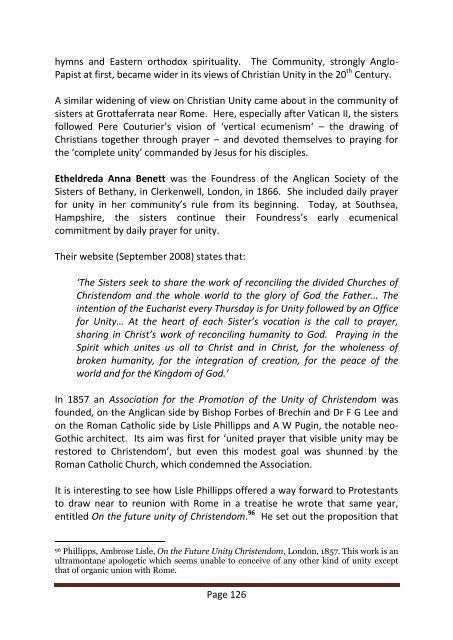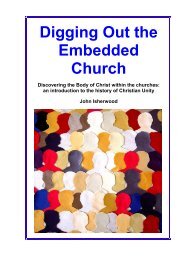Christian Unity (the book) - The Maranatha Community
Christian Unity (the book) - The Maranatha Community
Christian Unity (the book) - The Maranatha Community
Create successful ePaper yourself
Turn your PDF publications into a flip-book with our unique Google optimized e-Paper software.
hymns and Eastern orthodox spirituality. <strong>The</strong> <strong>Community</strong>, strongly Anglo-Papist at first, became wider in its views of <strong>Christian</strong> <strong>Unity</strong> in <strong>the</strong> 20 th Century.A similar widening of view on <strong>Christian</strong> <strong>Unity</strong> came about in <strong>the</strong> community ofsisters at Grottaferrata near Rome. Here, especially after Vatican II, <strong>the</strong> sistersfollowed Pere Couturier’s vision of ‘vertical ecumenism‘ – <strong>the</strong> drawing of<strong>Christian</strong>s toge<strong>the</strong>r through prayer – and devoted <strong>the</strong>mselves to praying for<strong>the</strong> ‘complete unity’ commanded by Jesus for his disciples.E<strong>the</strong>ldreda Anna Benett was <strong>the</strong> Foundress of <strong>the</strong> Anglican Society of <strong>the</strong>Sisters of Bethany, in Clerkenwell, London, in 1866. She included daily prayerfor unity in her community’s rule from its beginning. Today, at Southsea,Hampshire, <strong>the</strong> sisters continue <strong>the</strong>ir Foundress’s early ecumenicalcommitment by daily prayer for unity.<strong>The</strong>ir website (September 2008) states that:‘<strong>The</strong> Sisters seek to share <strong>the</strong> work of reconciling <strong>the</strong> divided Churches ofChristendom and <strong>the</strong> whole world to <strong>the</strong> glory of God <strong>the</strong> Fa<strong>the</strong>r… <strong>The</strong>intention of <strong>the</strong> Eucharist every Thursday is for <strong>Unity</strong> followed by an Officefor <strong>Unity</strong>… At <strong>the</strong> heart of each Sister’s vocation is <strong>the</strong> call to prayer,sharing in Christ’s work of reconciling humanity to God. Praying in <strong>the</strong>Spirit which unites us all to Christ and in Christ, for <strong>the</strong> wholeness ofbroken humanity, for <strong>the</strong> integration of creation, for <strong>the</strong> peace of <strong>the</strong>world and for <strong>the</strong> Kingdom of God.’In 1857 an Association for <strong>the</strong> Promotion of <strong>the</strong> <strong>Unity</strong> of Christendom wasfounded, on <strong>the</strong> Anglican side by Bishop Forbes of Brechin and Dr F G Lee andon <strong>the</strong> Roman Catholic side by Lisle Phillipps and A W Pugin, <strong>the</strong> notable neo-Gothic architect. Its aim was first for ‘united prayer that visible unity may berestored to Christendom’, but even this modest goal was shunned by <strong>the</strong>Roman Catholic Church, which condemned <strong>the</strong> Association.It is interesting to see how Lisle Phillipps offered a way forward to Protestantsto draw near to reunion with Rome in a treatise he wrote that same year,entitled On <strong>the</strong> future unity of Christendom. 96 He set out <strong>the</strong> proposition that96Phillipps, Ambrose Lisle, On <strong>the</strong> Future <strong>Unity</strong> Christendom, London, 1857. This work is anultramontane apologetic which seems unable to conceive of any o<strong>the</strong>r kind of unity exceptthat of organic union with Rome.Page 126








